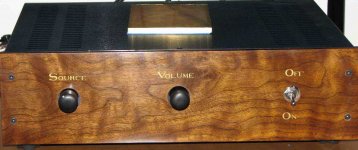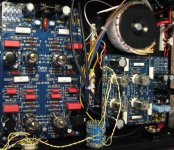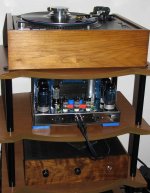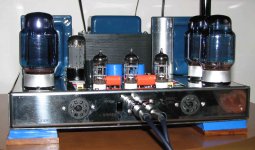I thought perhaps that my first DIY experience, building a tube preamp with John Broskie's Aikido line and Tetra phono stage PCBs, might help other newbies.
I started my preamp project searching for an excellent and reasonably priced kit and found almost universal acclaim for John Broskie's circuits. However, since I was not confident in my ability - or the steadiness of my arthritic hands - to solder small parts on the PCBs I discovered that Roy Mottram of tubes4hifi could do the PCBs for me. That was a very lucky find for me, as Roy - who has his own well respected products - gave freely of his time and expertise answering my numerous questions on how to build the preamp. He also pointed me to other suppliers for appropriate parts (e.g., transformers, chassis, upgrade capacitors) to complete the project. I purchased a stepped attenuator from Roy, for volume control, and that has turned out to be an excellent choice: a very fair price and a great product.
Anyway, I finally got everything wired together and, with hesitation, turned it on - half expecting something dreadful to happen. IT WORKED! The Aikido line stage was so quiet I didn't think it was on. There were, however, two problems with the Tetra phono stage: A loud hum from one channel and excessive sibilance and other high frequency noise. I posted a question regarding the hum, "How do I fix this", and received several good responses. Trying one thing after another I was fiddling with the input RCAs on the chassis and the hum would come and go, so it seemed that a poor connection was causing a ground loop. So, I opened up the chassis hole a little, put extra isolation washers and re-soldered the connections. Hurray, the ground loop was gone. Thinking that the sibilance was due either to the tubes I was using or perhaps too much gain I asked "Freecrowder", a member of this Forum, whether he had come across the same problem. "Freecrowder" suggested that I verify if a jumper or optional resistor was included on my PCB. It connects the RIAA high frequency attenuation circuit. I didn't have the connection so tried a 100ohm resistor and the high frequencies settled down. Now the phono stage is QUIET.
I've never had a super quality preamp, so my comment about the sound reproduction this unit accomplishes hasn't a good reference point; but if there is a better tube preamp then it would surely be magical. This preamp reproduces the detail, texture and musicality available from the source with realism, dynamism and many more isms. I am VERY happy and I thank all the kind and patient people who answered my questions, provided advice and helped me build my perfect preamp.
I started my preamp project searching for an excellent and reasonably priced kit and found almost universal acclaim for John Broskie's circuits. However, since I was not confident in my ability - or the steadiness of my arthritic hands - to solder small parts on the PCBs I discovered that Roy Mottram of tubes4hifi could do the PCBs for me. That was a very lucky find for me, as Roy - who has his own well respected products - gave freely of his time and expertise answering my numerous questions on how to build the preamp. He also pointed me to other suppliers for appropriate parts (e.g., transformers, chassis, upgrade capacitors) to complete the project. I purchased a stepped attenuator from Roy, for volume control, and that has turned out to be an excellent choice: a very fair price and a great product.
Anyway, I finally got everything wired together and, with hesitation, turned it on - half expecting something dreadful to happen. IT WORKED! The Aikido line stage was so quiet I didn't think it was on. There were, however, two problems with the Tetra phono stage: A loud hum from one channel and excessive sibilance and other high frequency noise. I posted a question regarding the hum, "How do I fix this", and received several good responses. Trying one thing after another I was fiddling with the input RCAs on the chassis and the hum would come and go, so it seemed that a poor connection was causing a ground loop. So, I opened up the chassis hole a little, put extra isolation washers and re-soldered the connections. Hurray, the ground loop was gone. Thinking that the sibilance was due either to the tubes I was using or perhaps too much gain I asked "Freecrowder", a member of this Forum, whether he had come across the same problem. "Freecrowder" suggested that I verify if a jumper or optional resistor was included on my PCB. It connects the RIAA high frequency attenuation circuit. I didn't have the connection so tried a 100ohm resistor and the high frequencies settled down. Now the phono stage is QUIET.
I've never had a super quality preamp, so my comment about the sound reproduction this unit accomplishes hasn't a good reference point; but if there is a better tube preamp then it would surely be magical. This preamp reproduces the detail, texture and musicality available from the source with realism, dynamism and many more isms. I am VERY happy and I thank all the kind and patient people who answered my questions, provided advice and helped me build my perfect preamp.
My Aikido/Tetra Preamp
Here are a couple of photos of the finished preamp which has a Tetra phono stage and an Aikido line stage. I am VERY happy with the sound, especially as today I installed Telefunken 12AX7 and Amperex 12AT7 in the phono stage and Bugle Boys in the line stage. It has a very low noise floor and the music it helps to amplify is superb.
Although I used a standard aluminum chassis I added a black walnut front piece to match the "apron" on my turntable. The lettering is available from hobby stores that cater to model train enthusiasts. The knobs were custom made from ebony. I know I could probably do much better, in the finishing department, but this was my first attempt at DIY.
Sitting on top of the preamp is a thick brass plate with EAR Isodamp glued to the bottom. This is intended to absorb vibration (if there is any, or indeed if it makes a difference).
Here are a couple of photos of the finished preamp which has a Tetra phono stage and an Aikido line stage. I am VERY happy with the sound, especially as today I installed Telefunken 12AX7 and Amperex 12AT7 in the phono stage and Bugle Boys in the line stage. It has a very low noise floor and the music it helps to amplify is superb.
Although I used a standard aluminum chassis I added a black walnut front piece to match the "apron" on my turntable. The lettering is available from hobby stores that cater to model train enthusiasts. The knobs were custom made from ebony. I know I could probably do much better, in the finishing department, but this was my first attempt at DIY.
Sitting on top of the preamp is a thick brass plate with EAR Isodamp glued to the bottom. This is intended to absorb vibration (if there is any, or indeed if it makes a difference).
Attachments
My Second DIY Build
Finishing the Tetra/Aikido preamp whetted my appetite for tubes so I obtained a Dynaco clone kit (ST-120) from Bob Latino and it is now finished as well. After some hectic days tracking down a weird LOUD hum, Bob noticed in a photo I sent him that I had (stupidly - my words not his) soldered the input jack wires incorrectly (i.e., ground to signal and vice-versa).
The preamp and amp combination is superb so I now call my audio rack "RetroRack." Although a CD player is included, the turntable and tubes predominate.
Finishing the Tetra/Aikido preamp whetted my appetite for tubes so I obtained a Dynaco clone kit (ST-120) from Bob Latino and it is now finished as well. After some hectic days tracking down a weird LOUD hum, Bob noticed in a photo I sent him that I had (stupidly - my words not his) soldered the input jack wires incorrectly (i.e., ground to signal and vice-versa).
The preamp and amp combination is superb so I now call my audio rack "RetroRack." Although a CD player is included, the turntable and tubes predominate.
My RetroRack and Bob Latino's ST-120
I call my amp "ol' blue eyes" since I painted the transformer end bells a Chevy blue (my eyes are blue) with flat black plates. The power tubes are JJ Electronic Blue Glass KT88s which coordinate nicely with the transformers, capacitors and the EAR Isodamp I'm using as part of the feet (the EAR is glued to walnut feet to match the preamp front and turntable apron which I also made. The driver tubes are Siemens ECC801S. At the moment the rectifier is a Sovtek 5AR4 which replaced a good/used Mullard which I fried when I was having the hum problem.
I call my amp "ol' blue eyes" since I painted the transformer end bells a Chevy blue (my eyes are blue) with flat black plates. The power tubes are JJ Electronic Blue Glass KT88s which coordinate nicely with the transformers, capacitors and the EAR Isodamp I'm using as part of the feet (the EAR is glued to walnut feet to match the preamp front and turntable apron which I also made. The driver tubes are Siemens ECC801S. At the moment the rectifier is a Sovtek 5AR4 which replaced a good/used Mullard which I fried when I was having the hum problem.
Attachments
Tubes used in the Tetra/Aikido
The Tetra has 2 X 12AX7 in the first position and 2 X 12AT7 in the second. Originally I was using inexpensive Japanese made RCA Blackplates (12AX7) and RCA Greyplates (12AT7) and they sounded fine but I was caught by the tube rolling bug so upgraded to extremely low noise good/used (I couldn't spend the $$ for NOS) Telefunken ECC83s and 1950s vintage NOS Amperex D-Getters. The Telefunkens made a large difference as there is now no noise/hum from the phono stage.
I also upgraded the 12AU7s in the Aikido line stage from RCA Cleartops to good/used Amperex Bugle Boys.
Well done. I also have one of Bob's VTA-70 kits. It's a fine amp, especially when using less efficient speakers. What tube type did you use in the Tetra?
The Tetra has 2 X 12AX7 in the first position and 2 X 12AT7 in the second. Originally I was using inexpensive Japanese made RCA Blackplates (12AX7) and RCA Greyplates (12AT7) and they sounded fine but I was caught by the tube rolling bug so upgraded to extremely low noise good/used (I couldn't spend the $$ for NOS) Telefunken ECC83s and 1950s vintage NOS Amperex D-Getters. The Telefunkens made a large difference as there is now no noise/hum from the phono stage.
I also upgraded the 12AU7s in the Aikido line stage from RCA Cleartops to good/used Amperex Bugle Boys.
Not a plinth but an apron
I built an "apron" for the Technics turntable, not a new plinth, because I changed out the feet - which were old and not working correctly - to brass cone spikes. These feet then sit on a 2"x2" frame of hard maple giving a nice solid support. I've used Sorbothane hemispheres under the maple to reduce effects of footfalls and other vibration. Because the turntable sits up higher than stock I built a three-sided apron to cover that extra space.
I chose black walnut, for its traditional look, and garnet shellac for color. My latest apron has inlaid banding for extra appeal.
Nice plinth on the 1200 (? i think)! Did you make it? I think that a Technics DD is a very underated turntable. I recieved my Tetra PCB today. I had a big grin.
I built an "apron" for the Technics turntable, not a new plinth, because I changed out the feet - which were old and not working correctly - to brass cone spikes. These feet then sit on a 2"x2" frame of hard maple giving a nice solid support. I've used Sorbothane hemispheres under the maple to reduce effects of footfalls and other vibration. Because the turntable sits up higher than stock I built a three-sided apron to cover that extra space.
I chose black walnut, for its traditional look, and garnet shellac for color. My latest apron has inlaid banding for extra appeal.
Tetra Topology
Well done on your build! Nice aesthetics too!
On the other hand, when I presented my own design of a CCDA driver stage, at least 5 forum members insisted it's the worst topology of all times, and that I should build a schade like everybody else. Maybe they ll want to share their opinion with you too.
Well done on your build! Nice aesthetics too!
On the other hand, when I presented my own design of a CCDA driver stage, at least 5 forum members insisted it's the worst topology of all times, and that I should build a schade like everybody else. Maybe they ll want to share their opinion with you too.
costis_n, I would have to refrain from any discussion on topologies since I have very little (actually none) knowledge of the subject. The phono (Tetra) and line stage (Aikido) sections of my preamp used boards produced by John Broskie so I didn't have anything to do with the design.
Nice job indeed Ken. A few things in common -- I also have one of Bob Latino's VTA - ST 70 amps, also here in Calgary. I'm assuming Calgary isn't your last name.
I'm using a Transcendent Phono, and wonder how the Tetra would compare. I'm guessing better, since the Aikido pre amp is something of a legend!
My question -- where did you obtain, and how did you learn to wire up the power supply for this?
Ok, that's two questions.
-Brenton
I'm using a Transcendent Phono, and wonder how the Tetra would compare. I'm guessing better, since the Aikido pre amp is something of a legend!
My question -- where did you obtain, and how did you learn to wire up the power supply for this?
Ok, that's two questions.
-Brenton
Hi Brenton, I am indeed in Calgary.
With regard to the power supply for the Tetra/Aikido boards I'm using an AnTek toroidal transformer (AN-1T250) that was recommended by Roy Mottram of tubes4hifi. AnTek can be reached through the Links on Par-Metal's web site. They are partner companies and I obtained my aluminum enclosure from Par-Metal. I just checked their web site and my transformer is now discontinued, though I'm sure they have a replacement.
Roy also helped me by sending a picture on how to wire the primary and secondary windings of that transformer for my particular project.
With regard to the power supply for the Tetra/Aikido boards I'm using an AnTek toroidal transformer (AN-1T250) that was recommended by Roy Mottram of tubes4hifi. AnTek can be reached through the Links on Par-Metal's web site. They are partner companies and I obtained my aluminum enclosure from Par-Metal. I just checked their web site and my transformer is now discontinued, though I'm sure they have a replacement.
Roy also helped me by sending a picture on how to wire the primary and secondary windings of that transformer for my particular project.
- Home
- Amplifiers
- Tubes / Valves
- My First DIY Experience: An Aikido/Tetra Preamp



